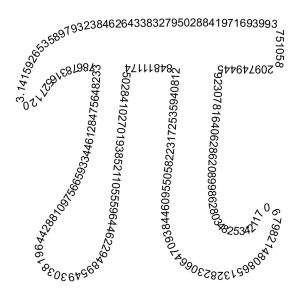 Pin
Pin Image by Andrew Martin from Pixabay
Mathematics reveals its most beautiful secrets through simple shapes, and the circle holds perhaps the greatest mystery of all. When you measure any circle’s circumference (the distance around its edge) and divide it by its diameter (the straight line across its widest point), you always get the same answer. This answer is pi, written as π, and it equals approximately 3.14159. But here’s where it gets interesting – those decimal places continue forever without ever repeating a pattern.
Think of it this way: you could draw a circle as small as a coin or as massive as the Earth’s orbit around the sun, yet this mathematical relationship stays perfectly constant. Ancient civilizations noticed this phenomenon thousands of years ago while building structures and making calculations. The story of who discovered pi and the hidden secret codes within it actually spans multiple cultures and centuries, each adding pieces to our understanding of this remarkable number that appears everywhere in nature, from flower petals to ocean waves.
Table of Contents
Ancient Babylonians and Their Clay Tablets
The earliest recorded attempts to calculate pi date back to around 1900 BC in ancient Babylon. Babylonian mathematicians working with cuneiform script on clay tablets used a value of 25/8, which equals 3.125. While this might seem crude by today’s standards, it was remarkably accurate for its time and served practical purposes in their architectural and engineering projects. These ancient scholars understood that circles had special properties, even if they couldn’t express the mathematics with modern precision.
What makes the Babylonian contribution so fascinating is how they arrived at their approximation through pure observation and practical measurement. They would measure physical circles using ropes and counting methods, then compare the circumference to the diameter repeatedly until they found a consistent pattern. Their approach laid the groundwork for more sophisticated mathematical techniques that would follow. This early work shows us that the quest to understand pi began not in abstract mathematical theory, but in the very real need to build structures, create pottery, and solve everyday problems that required circular calculations.
Egyptian Pyramids and the Rhind Papyrus
Around 1650 BC, Egyptian mathematicians made their own breakthrough in understanding pi, documented in the famous Rhind Papyrus. This ancient mathematical text, written by a scribe named Ahmes, contains problems that use pi with a value of (16/9)², which equals approximately 3.16. The Egyptians didn’t just stumble upon this number randomly – they developed it through a clever geometric method that involved inscribing squares within circles and calculating areas.
The most intriguing part of the Egyptian approach was how they connected pi to their monumental architecture. Some researchers believe that the builders of the Great Pyramid of Giza may have intentionally incorporated pi into its design. The ratio of the pyramid’s perimeter to its height closely matches 2π, though historians still debate whether this was deliberate or coincidental. What we do know for certain is that Egyptian mathematicians understood pi well enough to use it in complex calculations involving land measurement and construction projects. Their work represents a crucial step forward from simple approximations to more sophisticated geometric reasoning that would influence mathematical thinking for centuries to come.
Archimedes and the Birth of Mathematical Precision
The Greek mathematician Archimedes, working around 250 BC, revolutionized our understanding of pi through a brilliant geometric method that still impresses mathematicians today. Rather than relying on physical measurements like his predecessors, Archimedes developed a theoretical approach using polygons. He drew polygons with many sides both inside and outside a circle, creating boundaries that squeezed pi between two values. By calculating the perimeters of these polygons, he determined that pi must fall between 3.1408 and 3.1429.
This method represented a fundamental shift in mathematical thinking because Archimedes wasn’t just estimating pi – he was proving mathematical limits. His approach demonstrated that pi could be calculated to any desired level of accuracy simply by using polygons with more sides. This concept of approximation through limits would later become a cornerstone of calculus. Archimedes showed that mathematics could move beyond practical measurement into the realm of pure logic and proof. His work established pi as approximately 22/7, a fraction that remained the standard approximation for over a thousand years and is still commonly used today in basic calculations.
Chinese Mathematicians and the Power of Algorithms
During the 5th century AD, Chinese mathematician Zu Chongzhi achieved something remarkable that wouldn’t be matched in Europe for nearly a thousand years. Using sophisticated computational methods, he calculated pi to seven decimal places, determining it as 3.1415926. This level of precision was extraordinary for its time and demonstrates how advanced Chinese mathematics had become. Zu Chongzhi didn’t just stumble upon this accuracy – he developed systematic algorithms that could process complex calculations with unprecedented precision.
The Chinese approach differed significantly from Greek geometric methods because it focused on computational techniques rather than geometric proofs. Chinese mathematicians treated pi as a computational challenge that could be solved through careful, methodical calculation. They understood that achieving greater precision required not just better methods, but also the patience to carry out extremely lengthy calculations by hand. Zu Chongzhi’s work shows us how mathematical knowledge developed differently across cultures, with each civilization contributing unique approaches to the same fundamental problem. His achievement remained the world’s most accurate calculation of pi until the 15th century, highlighting the sophisticated mathematical capabilities that existed in ancient China.
The Renaissance Breakthrough and Infinite Series
The mathematical landscape changed dramatically during the Renaissance when European scholars began developing infinite series to calculate pi. In 1593, François Viète created the first known infinite product for pi, while Gottfried Wilhelm Leibniz later discovered an infinite series that could theoretically calculate pi to any number of decimal places. These mathematical tools represented a completely new way of thinking about pi – instead of geometric shapes or finite calculations, mathematicians could now use formulas that continued forever, each step bringing them closer to pi’s true value.
The beauty of infinite series lies in their conceptual elegance and practical power. Consider Leibniz’s formula: pi equals 4 times the sum of 1 – 1/3 + 1/5 – 1/7 + 1/9, and so on forever. While this series converges slowly (meaning you need many terms to get good accuracy), it demonstrates something profound about pi’s mathematical nature. These Renaissance discoveries showed that pi wasn’t just a number you could measure or approximate – it was deeply connected to the fundamental structure of mathematics itself. This realization opened doors to modern mathematical analysis and helped establish pi as one of the most important constants in all of mathematics, setting the stage for the computational advances that would follow centuries later.
Modern Computing and the Race for Precision
The invention of computers transformed pi calculation completely, turning what once took mathematicians years to accomplish into tasks that could be completed in seconds. In 1949, the first computer-assisted calculation of pi reached 2,037 decimal places using the ENIAC computer, which represented a monumental leap forward. This breakthrough demonstrated how electronic computation could tackle mathematical problems that were previously impossible due to the sheer volume of calculations required. The marriage of mathematical algorithms with computational power opened entirely new frontiers in understanding pi’s infinite decimal expansion.
What makes modern pi calculation so fascinating is how it pushes both mathematical theory and computer technology to their limits simultaneously. Today’s supercomputers can calculate trillions of digits of pi, but this isn’t just an exercise in showing off computational muscle. Each new record helps mathematicians test advanced algorithms, verify computer hardware reliability, and explore deeper questions about the nature of infinite sequences. The current world record holders use sophisticated mathematical formulas that would have been incomprehensible to ancient mathematicians, yet they’re still fundamentally trying to answer the same question that puzzled the Babylonians thousands of years ago. This progression shows how mathematical curiosity drives technological advancement, creating tools that benefit far more than just pi calculation.
The Hidden Patterns Inside Pi's Chaos
While pi appears to be a completely random sequence of digits, mathematicians have discovered surprising patterns and structures within its infinite decimal expansion that challenge our understanding of randomness itself. The digits of pi pass every statistical test for randomness, meaning that if you didn’t know better, you might think someone was just making up numbers by rolling dice. Yet beneath this apparent chaos lies a deeper mathematical order that emerges from pi’s geometric origins and its connections to fundamental mathematical constants like e (Euler’s number) and the golden ratio.
The most mind-bending aspect of pi’s digit sequence is how it seems to contain every possible combination of numbers somewhere within its infinite string. This property, called “normality,” means that your birthday, social security number, or any sequence you can think of theoretically appears somewhere in pi’s decimal expansion. But here’s where it gets even stranger: if we convert letters to numbers using a simple code, then entire books, poems, and even this very article could be hidden somewhere in pi’s digits. This concept pushes us to reconsider what we mean by “information” and “randomness.” Pi demonstrates that even numbers following strict mathematical rules can produce sequences so complex that they appear to contain all possible information, making it one of mathematics’ most profound puzzles.
Pi's Surprising Connections to Other Mathematical Constants
One of the most remarkable discoveries about pi involves its unexpected relationships with other fundamental mathematical constants, creating connections that seem almost too perfect to be coincidental. Euler’s identity, often called the most beautiful equation in mathematics, elegantly combines pi with e (the base of natural logarithms), i (the imaginary unit), and the numbers 1 and 0 in a single formula: e(iπ) + 1 = 0. This equation reveals that pi isn’t an isolated mathematical curiosity but rather an integral part of mathematics’ deeper structure, connecting geometry, algebra, and complex numbers in ways that continue to amaze mathematicians.
These connections extend far beyond elegant formulas into practical applications that touch nearly every field of science and engineering. Pi appears in quantum mechanics when describing wave functions, in statistics when working with normal distributions, and in electrical engineering when analyzing alternating current circuits. The constant shows up in places where you wouldn’t expect circles to be relevant at all, suggesting that pi reflects something fundamental about the mathematical fabric of reality itself. For example, the probability that two randomly chosen integers will have no common factors is 6/π², a relationship that seems to come out of nowhere yet has been rigorously proven. Such discoveries continue to reveal new layers of meaning in this ancient constant, showing that our understanding of pi is far from complete.
The Search for Meaning in Infinite Digits
The quest to find meaningful patterns within pi’s endless decimal expansion has become a fascinating blend of mathematics, computer science, and human curiosity about the nature of information itself. Researchers have developed sophisticated algorithms to search through billions of pi’s digits looking for specific sequences, birthdays, phone numbers, or encoded messages. While finding your birthday in pi might seem like a fun coincidence, it raises deeper questions about whether true randomness can exist in a number generated by such a precise mathematical relationship. This search process has revealed something profound about how we define and recognize patterns in seemingly chaotic data.
What makes this exploration particularly intriguing is how it mirrors our broader human desire to find meaning and order in apparent randomness. When we search for our personal information within pi’s digits, we’re essentially asking whether the universe’s mathematical constants contain some form of cosmic message or hidden blueprint. Scientists have used pi’s digit sequences to test random number generators, study statistical distributions, and even explore questions about the nature of mathematical truth itself. The fact that we can computationally search through trillions of pi’s digits represents a unique moment in human history where ancient mathematical curiosity meets modern computational power, allowing us to explore questions that previous generations could only dream about investigating.
Pi's Role in Modern Science and Technology
Pi’s influence extends far beyond pure mathematics into the technologies that shape our daily lives, often in ways most people never realize. GPS satellites orbiting Earth rely on precise circular orbit calculations that depend on pi to maintain their positioning accuracy. When your smartphone determines your location within a few meters, it’s using mathematical formulas involving pi to triangulate signals from multiple satellites. Similarly, engineers designing everything from car wheels to nuclear reactors must account for pi in their calculations, making this ancient constant an essential tool in modern engineering and manufacturing processes.
The digital revolution has created entirely new applications for pi that ancient mathematicians could never have anticipated. Computer graphics processors use pi extensively when rendering curved surfaces and rotating objects in video games and movies. Audio compression algorithms employ mathematical transformations involving pi to reduce file sizes while maintaining sound quality. Even artificial intelligence systems use mathematical operations containing pi when processing certain types of data patterns. This widespread technological dependence on pi demonstrates how fundamental mathematical discoveries can have practical implications that emerge centuries or even millennia after their initial development. The simple relationship between a circle’s circumference and diameter continues to enable technological advances that would seem like magic to the ancient civilizations who first began exploring this remarkable constant.
FAQs
Mathematically, yes! If pi is “normal” (which most mathematicians believe), then every finite sequence of digits appears infinitely often within pi’s decimal expansion.
Pi was discovered independently by multiple ancient civilizations! Babylonians, Egyptians, Greeks, and Chinese all contributed to our understanding over thousands of years.
These calculations test computer hardware, develop new algorithms, and help mathematicians study the fundamental nature of randomness and infinite sequences.
While pi’s digits appear completely random and pass all statistical tests for randomness, mathematicians continue searching for deeper patterns that might reveal new mathematical insights.
Pi emerges naturally in quantum mechanics, statistics, probability theory, and signal processing because it’s connected to fundamental mathematical relationships beyond just circular geometry.
































